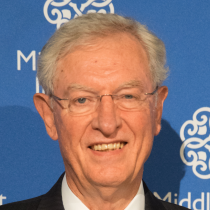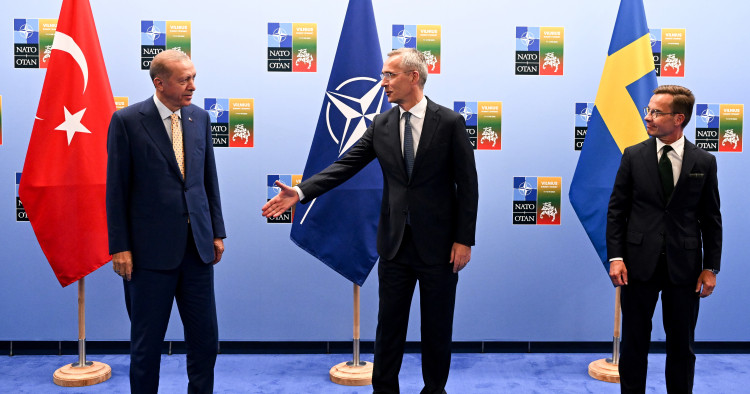Contents:
- Turkey-Sweden drama’s final act
- Zelenskyy meets with Erdoğan ahead of pivotal NATO summit
- Confluence of summer, El Niño, and climate change produces hottest days on record for globe, potential flooding in MENA
- Normalization between Turkey and Egypt: A move toward pragmatism?
- Iranian women protest hijab, calling into question government’s legitimacy
Turkey-Sweden drama’s final act
W. Robert Pearson
Non-Resident Scholar

-
Though the media believed Erdoğan would not agree this week to Sweden joining NATO, his decision was always going to be driven by his political aims at home and abroad.
-
In agreeing to Sweden’s membership, he wants to showcase his strength and confidence in shaping Turkish and regional opinion to his ends; being tough at home and abroad is critical to maintaining his base of support.
On Monday, July 10, North Atlantic Treaty Organization (NATO) Secretary-General Jens Stoltenberg announced that Turkish President Recep Tayyip Erdoğan had agreed to move forward on accepting Sweden’s accession to the Alliance. Leading up to the NATO summit in Vilnius, Lithuania, on July 11-12, Turkey played the Swedish NATO membership issue for every ounce of drama. On July 5, President Joe Biden said that the United States “fully, fully, fully” supports Sweden’s bid. And a meeting on the summit sidelines between him and his Turkish counterpart was reportedly “under discussion.” Though the parameters of the deal on Sweden are yet to be fully revealed, they will likely come at a significant price for the West.
Until today, the media consensus was that Erdoğan would not agree this week to Sweden joining NATO, which would have allowed him to leave open the door but continue his refusal as long as he wished. His real decision, however, was not going to be based on what Sweden is or is not doing.
Erdoğan’s real reason had to do with his political aims at home and abroad. His demand, earlier on Monday, for Turkey to be admitted into the European Union in exchange for Sweden’s accession to NATO illustrated the point. He all along wanted to showcase his strength and confidence in shaping Turkish and regional opinion to his ends. Erdoğan won his May 28 election with a strong appeal to Turkish ultra-nationalism. Domestically, his current political targets are the opposition strongholds of Ankara and Istanbul. Abroad, he has great ambitions to build up Turkey’s power and influence. Being tough at home and abroad is critical to maintaining his base of support. The June 28 desecration of a Quran in Sweden provided him a perfect opportunity.
Offsetting transatlantic anger were he to have refused Sweden, Erdoğan used the July 8 meeting with Ukrainian President Volodymyr Zelenskyy to burnish his NATO credentials. He pointedly said that Ukraine deserves membership in the Alliance, supported extending the maritime grain export deal, and permitted five Ukrainian commanders captured in the Mariupol siege and delivered by Russia to Turkish custody to return with Zelenskyy over Moscow’s protests. These steps would have allowed Erdoğan, if he chose to turn down Sweden, to emphasize that Ankara is a firm NATO member that supports Europe’s existential security concerns.
Now, he can return home as the man who forced the Alliance to protect Turkey’s interests. Moreover, he will lay down a marker on future Swedish actions, be able to call for quick action on the American F-16 offer, and could then harshly criticize the Europeans and Americans for not respecting Turkey’s vital concerns and importance to the Alliance.
He will return home a hero to strengthen his base, but just how long-lasting will Erdogan’s pivot be? A genius at tactics, is he ready to stay closer to NATO, or will the lure of a non-aligned independent course prove more appealing? Only time will tell.
Zelenskyy meets with Erdoğan ahead of pivotal NATO summit
Iulia-Sabina Joja
Director, Black Sea Program

-
Just a few days before the NATO summit in Vilnius, Ukraine’s head of state embarked on a multi-country tour to secure political and military support against Russia’s ongoing aggression.
-
Amidst the Russo-Ukrainian war, Turkey has managed to position itself as the only country “neutral enough” to mediate between Kyiv and Moscow, and it has capitalized on this to boost the Turkish economy with assistance from Russia, while keeping the Alliance on its toes with regard to Sweden’s membership.
Ukrainian President Volodymyr Zelenskyy’s first visit to Turkey since Russia’s full-scale invasion was marked by grand statements, promises, and an act of strong political symbolism. The grain export deal, prisoner exchanges, and Ukraine’s bid to join the North Atlantic Treaty Organization (NATO) all topped the bilateral agenda during his stay in Istanbul, on July 7-8.
Throughout this war, Turkey, though a NATO member, has managed to position itself as the only country “neutral enough” to be acceptable to both Ukraine and Russia as a mediating power. President Recep Tayyip Erdoğan has successfully capitalized on this newfound influential status to boost the Turkish economy with assistance from Russia, while keeping the Alliance on its toes with regard to Sweden’s membership. Zelenskyy’s visit last week did not lead to any breakthroughs; but through a series of symbolic gestures and declarations, it managed to reinforce Turkey’s balancing act between Russia and the West. According to Erdoğan, Zelenskyy’s visit will be followed by a visit from Russian President Vladimir Putin in August.
Just a few days before the July 11-12 NATO summit in Vilnius, Lithuania, Ukraine’s head of state embarked on a multi-country tour to secure political and military support against Russia’s ongoing aggression. Turkey has staunchly backed Ukraine’s NATO membership for over a decade, so Erdoğan’s grand declaration on the matter should not have come as any great surprise: “There is no doubt that Ukraine deserves NATO membership,” he said. But Zelenskyy could not secure any additional pledges for military aid from his host, unlike when he stopped in the other European countries on his trip — NATO members Bulgaria, Slovakia, and Czechia. Zelenskyy did, however, meet with Haluk Bayraktar, CEO of Turkish defense firm Baykar, which produces military drones powered by Ukrainian-built engines.
The one surprise to come out of the visit was Turkey’s release of five Ukrainian military commanders who led last year’s defense of Mariupol and were ordered to surrender. The Kremlin reacted with condemnation, lambasting Turkey for purportedly violating an agreement under which the five officers were supposed to remain in Turkish custody until after the war’s end. Neither Ukrainian nor Turkish officials have commented on the matter. The Kremlin’s spokesperson suggested Erdoğan’s decision to let the Ukrainian war prisoners leave for Ukraine was calculated to strengthen Turkey’s position in the context of the upcoming NATO summit. But though Erdoğan and his Ukrainian counterpart discussed Ankara facilitating the release of other prisoners, including thousands of kidnapped children and several Crimean Tatars, the freeing of five military commanders was a comparatively small gesture — albeit one marked by strong political symbolism.
Finally, while meeting with Zelenskyy, Erdoğan also referred to the deal on maritime exports of Ukrainian grain. The negotiation of this agreement, on which several Middle Eastern countries depend for their food security, is what has contributed most to Turkey being seen as a successful wartime mediator. Erdoğan has all the incentive to maintain the deal, but Russia has constantly threatened to cancel it. After several previous extensions, the deal is now set to expire on July 17. Erdoğan will likely succeed in prolonging it again, albeit for just a few months at a time. This, and possibly Putin’s upcoming visit, will help underpin Turkey’s reputation as a powerful mediator on the world stage.
Follow on Twitter: @IuliJo
Confluence of summer, El Niño, and climate change produces hottest days on record for globe, potential flooding in MENA
Mohammed Mahmoud
Senior Fellow and Director of the Climate and Water Program

-
An El Niño climate pattern confirmed to commence this summer and persist for the remainder of 2023 signals the advent of warmer temperatures.
-
An unprecedented week of extreme heat between July 3 and 6 saw the previous record for the hottest average global temperature broken three times.
Following months of climate projections that indicated a likely transition toward an El Niño global climate pattern, the World Meteorological Organization (WMO) recently confirmed the emergence of an El Niño signal starting this summer (greater than 90% probability, with El Niño conditions persisting through the remainder of 2023). El Niño represents the warming phase of the El Niño Southern Oscillation (ENSO) climate index, a recurring climate pattern that can also include a cooling phase (La Niña) or neither (Neutral). The impacts of ENSO climate patterns (El Niño, La Niña, or Neutral) vary from region to region across the world with respect to wet or dry (rainfall) and warm or cool (temperature) conditions.
Generally, El Niño brings with it above-average global temperatures. But the occurrence of El Niño during the warmest part of the year in the Northern Hemisphere (summer) can be even more extreme with respect to heat. Just last week, a new record for the hottest average global temperature was set on July 3, when it was measured to be 17.01°C. Only a day later, on July 4, this new record was broken when the average global temperature reached 17.18°C. This new high persisted on July 5, before it was broken again on July 6, when the average global temperature registered 17.23°C.
Prior to this stretch of unprecedented highs, the previous record of 16.92°C was measured on Aug. 13, 2016. The year 2016 turned out to be the hottest year on record; to date, the eight warmest years on record have all occurred during the period 2015-2022. Several months ago, the WMO released a report warning of a 98% likelihood that at least one of the next five years (2023-2027) will set a new record for average temperatures.
Beyond the direct and dangerous implications of record-breaking global temperatures, the impacts of El Niño on the Middle East and North Africa will mostly likely be indirect or secondary. For example, East Africa may see extreme rainfall. More rainfall in this part of the continent can translate to significantly higher flows in the Nile River Basin, a potential trigger for flooding in Sudan. Similarly, El Niño tends to produce more rainfall in Central Asia, making Iran (where some correlation between ENSO and climate has been found to be significant) a potential recipient of these wetter conditions.
Regardless of the secondary effects El Niño may have in the MENA region this year, the current trajectory of future global climate is gravely alarming. With climate projections indicating that warming conditions will continue to persist in the near-term, we may no longer be able to curb future global warming to below 1.5°C. But as dire as these climate conditions appear now, delayed action on mitigating climate change threatens to bring about even worse outcomes than we see today.
Normalization between Turkey and Egypt: A move toward pragmatism?
Meliha Benli Altunışık
Non-Resident Scholar

-
Turkey-Egypt normalization had a slow start as, over time, the main issues between the two sides — Libya and the Eastern Mediterranean — had become regional issues, rather than bilateral ones.
-
Turkey-Egypt normalization is occurring in the context of a region-wide push for normalization. It is also due to the unsustainability of conflictual zero-sum policies and the “pragmatist turn” in both Cairo and Ankara.
Ten years after downgrading their diplomatic relations, going through an intense war of words (especially after the change of government in Egypt in 2013), and experiencing fierce competition and at times rivalry in Libya and the eastern Mediterranean, Turkey and Egypt announced the upgrading of their diplomatic relations last week. This important foreign policy shift has been in the making for the past two years after the two countries began holding “exploratory talks” between diplomats at the deputy foreign minister level, first in Cairo in May 2021 and then in Ankara that September. Although these talks led to the elimination of one of the hurdles to normalizing relations, namely Turkey’s hosting of and support for some Egyptian Muslim Brotherhood members as well as a general toning down of rhetoric on both sides, they failed to transform the relationship. In fact, unlike other normalization policies in the region, Turkey-Egypt normalization had a slow start as, over time, the main issues between the two sides had become regional issues, namely Libya and the Eastern Mediterranean, rather than bilateral ones.
The normalization process recently picked up pace. An important turning point was the November 2022 meeting between Presidents Recep Tayyip Erdoğan and Abdel-Fattah el-Sisi at the FIFA World Cup in Qatar. It eliminated a significant hurdle, as the rivalry from the beginning had a personal angle. Recently, earthquake diplomacy has also created positive momentum. Sisi called Erdoğan, Egypt sent aid, and Egyptian Foreign Minister Sameh Shoukry visited earthquake-stricken regions with his Turkish counterpart, Mevlüt Çavuşoğlu. In March 2023, Foreign Ministers Çavuşoğlu and Shoukry held talks in Cairo, and a reciprocal meeting was held in Ankara the following month. Finally, the two countries made their announcement about upgrading their diplomatic relations. In the meantime, Sisi is expected to visit Turkey soon.
Parallel to the normalization of diplomatic relations, new agreements were signed to further energy, trade, and investment ties. Despite years of highly problematic political relations, economic relations between the two countries were increasing. But the normalization has already been reflected in improved economic ties. Today, Egypt is Turkey’s largest trading partner in Africa. The volume of trade increased from $5.4 billion in 2019 to $7.1 billion in 2022, up about 31%.
The normalization of relations between Turkey and Egypt is occurring in the context of a region-wide push for normalization. It is also due to the unsustainability of conflictual zero-sum policies and the “pragmatist turn” in both Cairo and Ankara. Amid all this, the situation in Libya constitutes the crux of relations. However, the shift in the two countries’ positions in Libya contributed to the dampening of the rivalry. Egypt realized the limitations of a policy of supporting Khalifa Hifter and his Tobruk-based Libyan National Army forces due to the changing military and diplomatic contexts. Thus, Cairo also started to reach out to the Tripoli-based government. Turkey, on the other hand, realized the importance of reaching out to the actors in the east to make the transition to a more stable Libya. Therefore, the two countries recently intensified their dialogue on Libya and at least agreed on a common goal of stability in that country. The decrease in tensions in the Eastern Mediterranean helped facilitate normalization as well. On both of these issues, challenges and divergences continue to exist. However, Turkey and Egypt decided to adopt a pragmatist stance amid the changing domestic and geopolitical context and pursue a policy of dialogue and compartmentalization to deal with these challenges for now.
Iranian women protest hijab, calling into question government’s legitimacy
Marjan Keypour
Non-Resident Scholar

-
Ongoing tensions around the hijab illustrate how the Iranian government continues to impose a plethora of draconian restrictions on its citizens even as it proves itself incapable of enforcing them.
-
The weaponization of the hijab and its enforcement mechanism have become a wedge issue even among the most religious segments of society and the inner circles of the regime.
Ten months since the outbreak of the fervent and widespread “Woman, Life, Freedom” street protests shook Iran, the movement has mostly subsided; but the government and the public now find themselves at a critical inflection point. As the country’s social, economic, and environmental problems become more pervasive, ever more citizens are concluding that their government is incapable and unwilling to fulfill its basic obligations. In reaction to this sobering realization, beyond protests, Iranians have been expressing their frustration by rejecting the government’s repressive measures. Illustrative of this has been redoubled opposition among many Iranian women to wearing the hijab, which in turn has provoked new repressive measures by the state. The ongoing tensions around the hijab illustrate how the government continues to impose a plethora of draconian restrictions on its citizens even as it proves itself incapable of enforcing them.
While regions of the country reel from record-breaking heat, shortages of clean water, and even a lack of electricity for cooling systems, the government has been focusing on developing new measures to encourage and enforce the hijab, purportedly to preserve families and protect the safety and security of the nation. Earlier this month, parliamentarians rushed to review a bill in support of “the Culture of Hijab and Chastity” as a matter of “urgency.” The proposed legislation would levy a hefty fine of 900 million tomans (more than $21,000) a month on women who defy the hijab or do not meet the regime’s modesty standards. Officials are so determined to enforce the mandatory hijab that they are threatening violators with restrictions on their bank accounts, denial of social services, confiscation of private cars, forfeiture of passports, and of course, prison sentences.
On July 8, the authorities launched a weeklong multimedia-heavy “Chastity and Hijab” campaign to popularize the hijab. Posters of faceless women dressed in multilayered head coverings and the chador have been plastered all over Iranian public spaces. Government-affiliated radio and television stations are “honoring” the week with a series of programs featuring poems, essays, and personal accounts of the benefits of modest dress and head coverings for women. Schools, which earlier this year saw widespread poisonings of girls, received new protocols to observe the week. Hijab was presented as everything from a solution to marital problems to protection against foreign enemies.
Recognizing their inability to repress and police millions of citizens, the authorities rely on the vigilance of ordinary civilians — store owners, gym managers, government employees, and program administrators — to deny services to women who exhibit poor hijab. Already beset by myriad economic challenges, desperate business owners now have to take on the new charge of evaluating their customers’ dress and refusing service to perceived rebels. Various businesses that failed to “cooperate” with these enforcement measures have faced forcible closures, and along with them financial hardship and destitution. These measures are particularly pernicious as they pit Iranians, who had experienced a moment of unity since the murder of Mahsa Amini, against one another, forcing them to choose between each other’s freedom and their own livelihood.
Despite the government’s determination to enforce the hijab, Iranian women continue to engage in direct confrontations with the regime by unveiling in public and, in doing so, facing the risk of beatings, harassment, and imprisonment for making their own choices about their attire. Nor is the authorities’ crackdown popular with more socially conservative Iranians: Up to 60% of the hijab-observing population opposes the government’s entanglement with the issue. The weaponization of the hijab and its enforcement mechanism have, thus, become a wedge issue even among the most religious segments of society and the inner circles of the regime. So as Iran’s women exercise their self-determination by protesting the hijab, they in fact call into question the legitimacy of the regime itself.
Follow on Twitter: @MarjanKG
Photo by Filip Singer - Pool/Getty Images
The Middle East Institute (MEI) is an independent, non-partisan, non-for-profit, educational organization. It does not engage in advocacy and its scholars’ opinions are their own. MEI welcomes financial donations, but retains sole editorial control over its work and its publications reflect only the authors’ views. For a listing of MEI donors, please click here.













